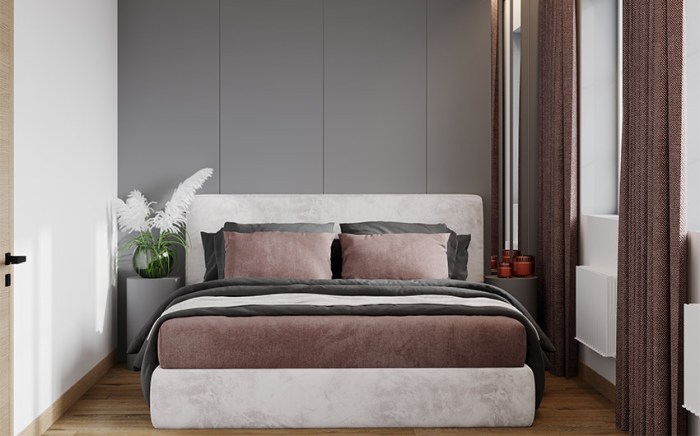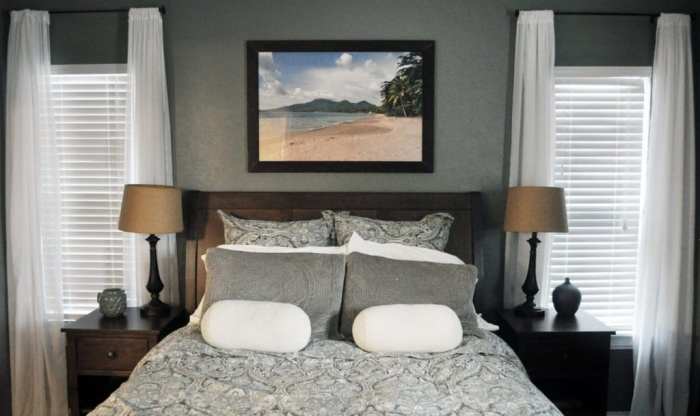Maximizing Natural Light in Small Bedrooms

Small bedroom window design – Making the most of natural light in a compact bedroom is key to creating a space that feels airy and spacious, rather than cramped and gloomy. Clever design choices can transform even the smallest room, bringing in that vital dose of sunshine and improving your overall wellbeing. This involves a careful consideration of window treatments, furniture placement, and even the type of window itself.
Design Choices for Window Treatments
Choosing the right window dressings is crucial for balancing privacy and light maximization in a small bedroom. Heavy curtains, while lovely, can significantly reduce the amount of light entering the room. Instead, consider lighter options that allow ample natural light to filter through while still offering a degree of privacy.
| Type | Description | Light Penetration | Privacy Level |
|---|---|---|---|
| Sheer Curtains | Lightweight, often translucent fabrics that diffuse light beautifully. They come in a variety of colours and textures. | High | Moderate – offers some privacy during the day, less so at night. |
| Roller Blinds | Simple and effective, these blinds can be raised fully for maximum light or lowered for privacy. Consider translucent fabrics for daytime privacy. | Variable – high when raised, adjustable when lowered. | Variable – high when lowered, low when raised. |
| Cellular Shades | These shades offer excellent insulation and can be made from light-filtering fabrics. They provide a clean, modern look. | Variable – depending on fabric choice and shade position. | Moderate to High – depending on fabric opacity and shade position. |
| Venetian Blinds | Classic and versatile, Venetian blinds allow for precise light control. However, the slats can sometimes appear busy in small spaces. | Variable – adjustable via slat angles. | Moderate – adjustable via slat angles. |
Impact of Window Placement and Orientation
The placement and orientation of your windows significantly affect the amount of natural light your bedroom receives. South-facing windows generally receive the most sunlight throughout the day, while north-facing windows receive softer, more diffused light. East-facing windows get morning sun, and west-facing windows get afternoon sun. Understanding this can help you strategically place your furniture to make the most of the available light.For example, placing your bed against a wall with a south-facing window would allow you to enjoy the sunlight in the morning.
Positioning a desk or vanity near a north-facing window would provide consistent, diffused light for working or applying makeup. Avoid placing large pieces of furniture directly in front of windows, as this blocks the light.
Comparison of Window Types and Light Penetration
Different window types offer varying levels of light penetration. Casement windows, which open outward on hinges, generally offer better ventilation and can be opened fully to maximize light and air flow. Double-hung windows, which have two sashes that slide vertically, are a classic choice, offering good light penetration. Bay windows, which project outwards from the wall, dramatically increase the amount of light entering the room, creating a brighter and more spacious feel, though they are a more significant structural change.
For small bedrooms, casement or double-hung windows are practical choices; bay windows, while desirable for light, may be less practical due to space constraints.
Visual Expansion Techniques with Window Design: Small Bedroom Window Design
Making a small bedroom feel spacious is all about clever design tricks, and the window is your secret weapon. By carefully considering the frame, the colours, and even the placement of a mirror, you can dramatically alter the perception of space, transforming a cramped room into a surprisingly airy haven. Think less about adding square footage and more about manipulating the eye.
The key is to create a sense of visual continuity and depth, blurring the lines between the interior and the exterior. This can be achieved through a combination of colour choices, strategic use of reflective surfaces, and thoughtful window treatments.
Window Frame and Molding Choices for Enhanced Openness
The window frame itself plays a crucial role. Thin, minimalist frames, painted in a colour that complements the wall, will recede visually, making the window appear larger and the room feel more expansive. Avoid bulky, ornate frames, which will only draw attention to the window’s limitations and make the room feel smaller. Similarly, consider the molding.
Simple, clean lines around the window will enhance the sense of openness, whereas elaborate moldings can have the opposite effect. Imagine a small bedroom with a simple white window frame, almost disappearing against a pale grey wall. The eye is drawn to the view beyond, creating an illusion of greater space. Contrast this with a dark brown, heavily ornamented frame which would instantly make the window and the room feel smaller and more confined.
Strategic Mirror Placement to Amplify Light and Space
Mirrors are your best friend in a small bedroom. Strategically placed near a window, they can double, even triple, the amount of natural light entering the room. This creates a brighter, more airy atmosphere, instantly making the space feel larger.
The effectiveness of mirrors hinges on their placement and size. Here’s how to maximize their impact:
- Place a large mirror directly opposite the window. This will reflect the natural light deep into the room, illuminating even the furthest corners.
- Use a series of smaller mirrors clustered together near the window. This creates a more dynamic effect, scattering the light in multiple directions.
- Opt for mirrors with simple, unobtrusive frames. Ornate frames can detract from the overall effect and make the room feel cluttered.
Light-Colored Window Treatments for Spaciousness, Small bedroom window design
Heavy, dark curtains or blinds will instantly shrink a small bedroom. Instead, choose light-colored, sheer curtains or blinds that allow plenty of natural light to filter through. These will not only brighten the room but also create a sense of airiness and openness. Think of gauzy white linen curtains gently billowing in the breeze, or bamboo blinds that allow dappled sunlight to stream in.
These light and airy fabrics help to maintain a sense of spaciousness, unlike heavier, darker materials that can create a feeling of enclosure.
Incorporating Window Seating
Adding a window seat to a small bedroom is a seriously savvy move, blending practicality with style. It’s a chance to maximise space, boost natural light, and create a seriously chill-out zone. Think of it as reclaiming often-wasted space and turning it into a design statement.A well-designed window seat can dramatically improve the feel of a small bedroom, offering both a comfortable spot to relax and valuable storage.
The key is careful planning and execution to ensure it doesn’t overwhelm the room.
Built-in Window Seat Design
Imagine a built-in window seat, approximately 1.5m wide and 0.5m deep, nestled beneath a window. The height is around 0.45m from the floor, making it comfy to sit on. The seat itself is constructed from sturdy, reclaimed scaffold boards, lightly sanded and finished with a clear, matte varnish to retain their natural texture and character. These boards sit on a frame of painted, dark grey metal, offering a pleasing contrast.
The back and sides of the seat are upholstered in a durable, grey-toned fabric with a subtle herringbone pattern, echoing the industrial feel of the metal frame. Cushions, in a lighter grey linen, complete the look, offering a soft contrast against the darker seat and metal.The overall aesthetic is a blend of urban industrial and minimalist Scandi styles.
The dark metal and natural wood create a robust, grounded feel, whilst the light grey fabric and cushions introduce a sense of calm and sophistication. The image conjures a feeling of a sun-drenched space, with the warm light highlighting the natural wood grain and the soft textures of the fabric.
Maximizing Storage Within a Window Seat
Clever storage solutions are key to making the most of a window seat in a small bedroom. One option is incorporating hinged lift-up storage within the seat itself. This could house bedding, extra blankets, or even out-of-season clothing. Alternatively, shallow drawers, built into the frame underneath the seat, could be used for storing books, magazines, or personal items.
These could be fitted with soft-close mechanisms for a quieter, more refined experience. Another idea is to add open shelving on the sides of the seat, perfect for displaying plants, books, or decorative items, creating a visually appealing feature.
Benefits and Drawbacks of Incorporating a Window Seat
Incorporating a window seat offers several significant advantages. It provides extra seating, a cosy reading nook, and valuable storage, all within a small space. It can also improve natural light diffusion by allowing light to bounce off the seat’s surface, brightening the room. However, a window seat does require careful planning and can potentially reduce floor space. The construction and materials can also be costly, depending on the level of customisation and the quality of materials used.
Finally, depending on the design, accessing storage might be slightly less convenient than with other storage solutions.
Maximizing light in a small bedroom is key, and smart window design plays a huge role. Think strategically about placement and size to create an airy feel, even in a compact space. Of course, if you’re designing a larger home, like an 8 bedroom house design , you have more flexibility, but even there, thoughtful window placement in each room is crucial for a well-lit and comfortable atmosphere.
Ultimately, the principles of good small bedroom window design apply no matter the overall house size.
Blending Indoor and Outdoor Spaces

Bringing the outside in is key to making a small bedroom feel bigger and brighter, especially in a bustling urban environment. Clever window design can blur the lines between your personal sanctuary and the city outside, creating a sense of calm and spaciousness. Think less cramped box, more tranquil escape.A well-planned window arrangement can transform a small bedroom into a haven.
Imagine waking up to the gentle morning light filtering through strategically placed greenery, creating a natural, calming atmosphere. This connection between the indoor and outdoor environment enhances the overall mood and aesthetic appeal of the space.
Window Arrangement and Greenery
To seamlessly blend indoor and outdoor spaces, consider a floor-to-ceiling window or a series of strategically placed smaller windows, maximising natural light and views. Incorporate window boxes brimming with trailing plants like ivy or petunias, creating a vibrant, green border that softens the transition between the inside and outside. Inside, place potted plants of varying heights and textures on window sills to complement the outdoor greenery, creating a continuous flow of nature.
Imagine a large, south-facing window, nearly floor-to-ceiling, showcasing a lush cityscape. A window box filled with trailing geraniums adds a splash of vibrant red, mirrored by a matching pot of geraniums on the sill. A taller peace lily sits next to it, its white flowers contrasting beautifully with the red. This creates a layered, vibrant scene that connects the indoor and outdoor spaces visually and aesthetically.
Appropriate Window Coverings
Choosing the right window coverings is crucial for maintaining privacy while still enjoying the outdoor views. Sheer curtains or blinds allow ample natural light to flood the room while providing a soft, diffused filter for privacy. Consider roller blinds in a light, neutral colour for a minimalist look that doesn’t obstruct the view. For complete privacy at night, heavier curtains can be added.
These could be in a darker, richer colour to create a cosy atmosphere when drawn, adding a layer of sophistication to the space. Think sleek, charcoal-grey linen curtains that add a touch of urban chic, complementing the city views.
Window Styles for Enhanced Connection
Bay windows, French doors, or even large sliding glass doors dramatically enhance the connection between the interior and exterior. A bay window offers additional space for a small seating area or a writing desk, making the most of the light and view. French doors, if suitable for your building, can create a truly seamless transition, allowing easy access to a balcony or small patio.
Large sliding glass doors, if space allows, can practically erase the boundary between inside and outside, creating a stunning visual connection with the outdoors. Imagine a bay window filled with vibrant cushions and throws, overlooking a bustling street scene below. The window becomes a feature, a focal point, blurring the lines between the small bedroom and the exciting energy of the city.
Essential Questionnaire
What is the best window type for a small bedroom?
The best window type depends on your needs and preferences. Casement windows maximize airflow, while double-hung windows offer versatile ventilation. Bay windows add depth and light but take up more wall space.
How can I make my small bedroom feel brighter?
Use light-colored walls and window treatments to reflect light. Strategically place mirrors to bounce light around the room. Trim overgrown plants or shrubs outside that might be blocking sunlight.
What are some low-maintenance window treatment options?
Cellular shades and roller blinds are easy to clean and operate, requiring minimal maintenance. Consider faux wood blinds for a durable, low-maintenance alternative to real wood.
How much will a window seat cost?
The cost varies greatly depending on materials, size, and complexity. A simple DIY project could be relatively inexpensive, while a custom-built seat can be quite costly.
